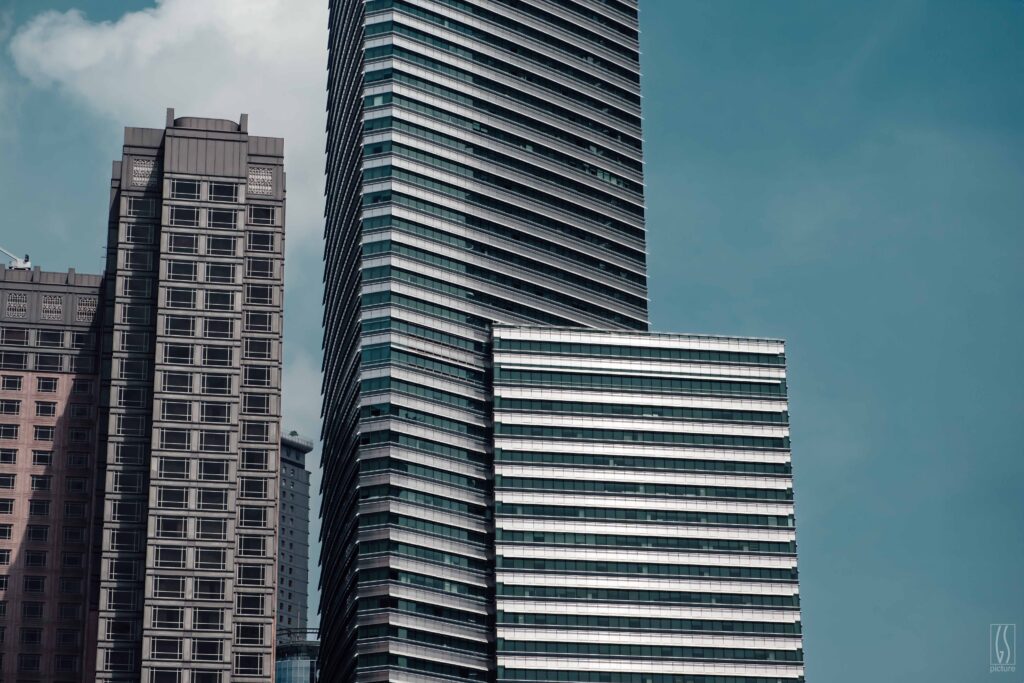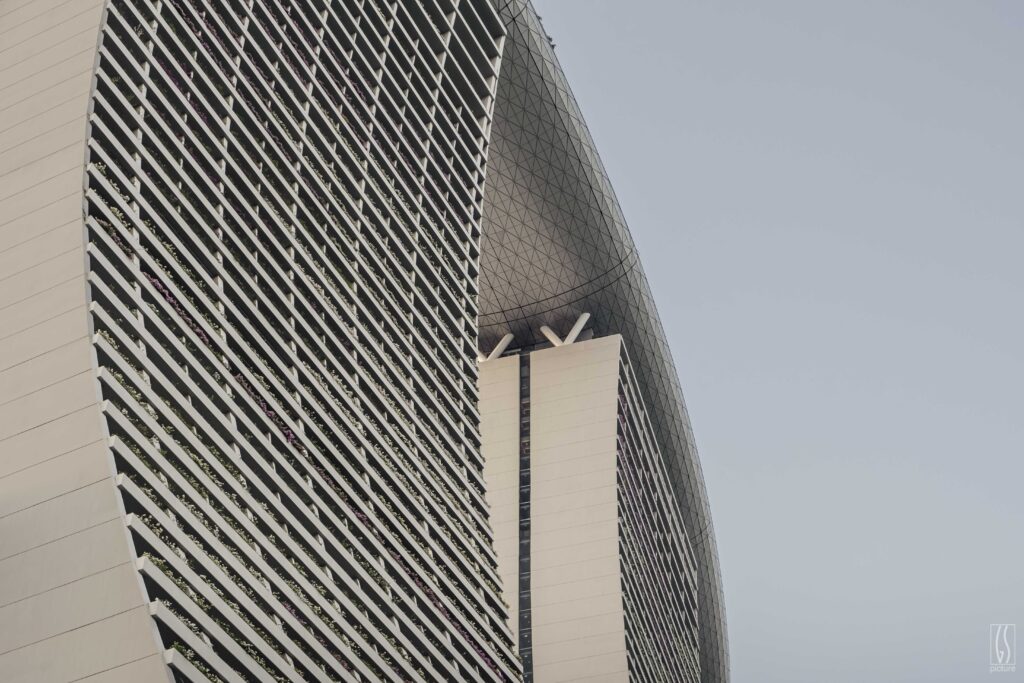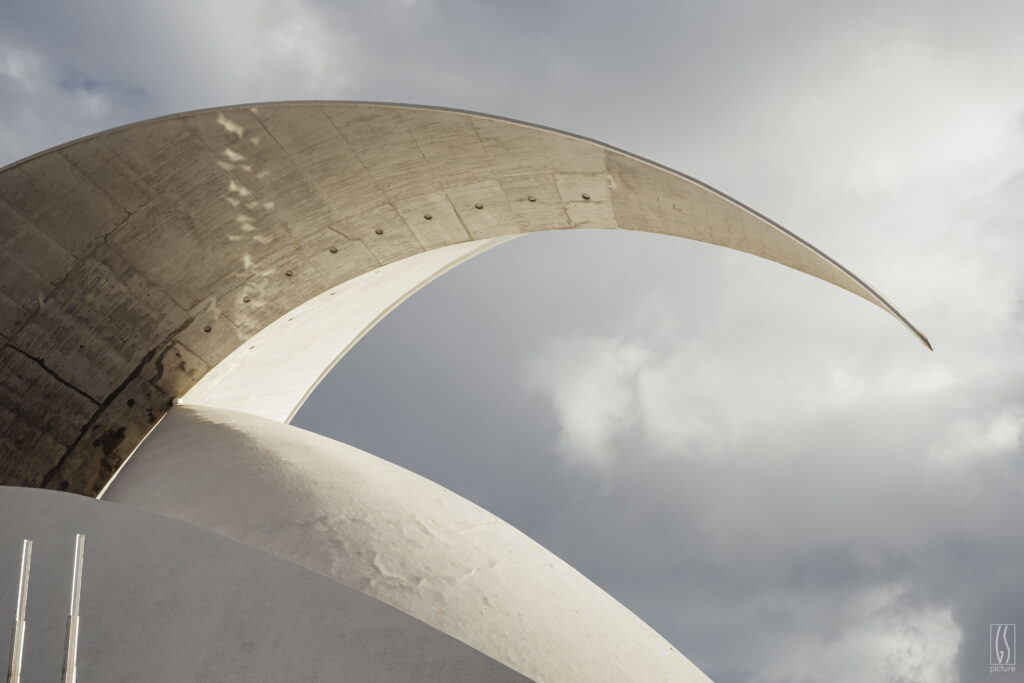Buildings, these immovable giants, have so many stories to tell and shapes to share. Yet, capturing their essence in a photo can be much more complex than it seems. Too many shapes, too many details, too much information—what angle should you start with? The good news? You don’t need the latest high-tech gear or an architecture degree to succeed. With a bit of curiosity and persistence, you can transform your shots into true works of art. Let’s dive into some tips on architectural photography.
If you’d like to see some examples of this type of photography, feel free to check out my Instagram or the portfolio page on my website.

1. Take your time
The building before you wasn’t built in a day (and by extension, Paris wasn’t built in a day either).
Before you even press the shutter button, take a moment to explore. Observe the building from every angle, and study how the light interacts with its surface. Early mornings and late afternoons often offer soft, flattering light that’s ideal for photography. Be prepared to get a little sore-footed—walking around the building is essential to finding, through persistence, the angle that offers an interesting perspective.
For instance, a Gothic cathedral might reveal stunning details at sunrise, while a modern skyscraper glows with golden reflections at dusk. The key? Patience. Be ready to wait for the perfect moment.
That said, harsher light also has its perks, creating stronger contrasts and intense shadow zones. You can highlight specific elements using this high contrast to your advantage.
2. The angle is everything!
A building can transform from ordinary to spectacular depending on the angle from which you photograph it. Architectural photography is like a game of perspectives: each position tells a unique story.
Experiment with the classics:
- Frontal view: Ideal for capturing symmetry or clean architectural lines. This works well for historic monuments, ornate facades, or modern buildings.
- Low-angle shot: Stand at the base of a skyscraper or a bridge and point your camera upward. This angle emphasizes the building’s grandeur and conveys a sense of power.
- Bird’s-eye view: If you can access a higher vantage point (a terrace, drone, or even a staircase), try photographing the building from above. This reveals hidden patterns in rooftops or surrounding landscaping.
Try original perspectives:
- Play with diagonals to guide the viewer’s eye through the image. For example, a staircase photographed from an unconventional angle can create a dynamic shot.
- Shoot from inside: Frame your shots using windows, arches, or colonnades to add depth and a storytelling element to your composition.
Look for reflections and interactions:
- A building becomes even more intriguing when reflected in a nearby glass window or a puddle. These interactions manipulate angles and create an almost surreal effect.
- Cast shadows, often overlooked, can add drama to a scene. Imagine intricate patterns on the ground created by the shadow of a wrought-iron balcony.
Embrace geometry:
Architecture is full of geometric shapes. Use these to craft graphic compositions:
- Capture rectangles nestled within triangles or circles juxtaposed with straight lines.
- Seek out perfect symmetry. In spiral staircases or mirrored facades, symmetry provides a striking visual balance.
Practical tip:
To find the best angle, experiment by moving around the building and trying different perspectives. Use your camera or smartphone screen to preview your composition. Don’t forget to check the background—a misplaced streetlamp or pole can ruin an otherwise perfect shot.

3. The magic of details
Large buildings impress with their size, but it’s often the small details that tell their true story. Taking the time to zoom in on these unique elements can turn an ordinary photo into an artistic masterpiece.
Look for the unique in the ordinary:
- Study the materials: the grain of wood, the texture of raw concrete, or the shine of glass can be incredibly photogenic. For instance, cracks in an old wall or the regular patterns of bricks in an industrial building bring a touch of authenticity.
- Spot ornamentation details: sculptures, mosaics, bas-reliefs, or murals are often hidden treasures. A statue in the shadow of a cathedral or a floral motif on a wrought-iron balcony can become the main subject of your photo.
Play with repeating patterns:
Architectural motifs like aligned windows, columns, or identical balconies create fascinating compositions. A close-up shot highlights these repetitions while revealing imperfections that tell the building’s story.
Light, your precious ally:
- Soft shadows in natural light reveal the textures of surfaces. For example, raking light on a stone facade emphasizes every crack and relief.
- Capture details in direct light for strong contrasts, or in diffused light for a subtler ambiance.
Get close or zoom in:
You don’t need a fancy telephoto lens to photograph details. Even a modern smartphone with a macro mode can capture the rivets of a bridge, the grain of an old door, or the intricacy of a molding. If using a camera, opt for a lens with a focal length between 50mm and 100mm to isolate the details.
Add meaning to your photos:
Details aren’t just pretty—they add meaning to your images. A gargoyle overlooking a street can evoke a time when superstitions influenced building design. An ornate door handle on a modern building shows attention to every detail, even the smallest.
Practical tip:
Experiment with different angles to capture details from a fresh perspective. Try a low-angle shot to emphasize the grandeur of a wall sculpture or a high-angle shot to capture mosaics on the ground. Don’t be afraid to get creative!
4. Minimalism as a photographic style
When it comes to photography, minimalism can be your greatest ally. By simplifying your compositions, you highlight the essentials: the shapes, lines, and structures that define a building.
Less is more:
In a complex urban environment, it can be tempting to include everything that catches the eye. But in architecture, strength often lies in simplicity. Focus on a distinctive feature of the building:
- A geometric corner of a structure.
- A single colorful window on a gray facade.
- A silhouette against an empty sky.
By removing distractions, you give your image impact and make the architecture more legible.
Let your subject breathe:
Use negative space—the empty areas around the building—to enhance the dramatic effect. For instance, a triangular roof pointing toward a perfectly blue sky immediately draws the eye. These “airy” compositions convey a sense of calm and emphasize the main forms.
Seek strong contrasts:
Minimalism often goes hand-in-hand with striking contrasts. Play with:
- Light and shadow: A white wall lit directly can create graphic shadow patterns.
- Colors: A bright red door on a white facade or a vivid yellow building against a stormy sky.
- Textures: A smooth wall next to a rough surface or a shiny metallic roof against raw stone walls.
Compose like a painter:
Take inspiration from minimalist art by seeking strong geometric forms. Architects often design their buildings like modern art pieces, and you can treat them the same way. Look for:
- Circular windows or portholes.
- Interlocking rectangles and squares on modern facades.
- Triangles formed by roofs or metal structures.
The magic of clean lines:
Lines are everywhere in architecture. Use them to guide the viewer’s gaze. Horizontal lines evoke stability and calmness, while vertical lines emphasize grandeur.
Practical Tip:
If your photo seems too “busy,” take a moment to adjust your framing. Remove elements that don’t add to the story you want to tell. Sometimes, a small crop or zoom is all it takes to transform a cluttered photo into a striking minimalist masterpiece.

5. Play with shadows and reflections
In architectural photography, light is much more than just a tool for illumination—it’s a creative partner. Shadows and reflections can transform static scenes into dynamic, intriguing compositions.
Contrasts, subtle artists:
Playing with shadows add contrast and depth to your photos. They reveal textures, create patterns, and add a touch of mystery. For instance:
- Shadows from railings or grilles create interesting geometric patterns on walls or floors.
- Light passing through stained glass projects vibrant colors and unique shapes.
Long shadows during sunrise or sunset are particularly spectacular. They highlight reliefs and give the building a sense of volume, perfect for capturing its unique character.
Reflections, a magical dimension:
Reflections allow you to play with double perspectives and add an almost surreal effect to your images. Look for reflective surfaces around the building:
- Water: A puddle after the rain or a canal can turn an ordinary scene into a stunning mirrored artwork. Frame your photo to include both the building and its reflection.
- Glass: The windows of a modern building or nearby shopfronts can capture the reflection of an old church, creating a fascinating temporal contrast.
- Metal surfaces: A steel sculpture or chrome roof often reflects distorted, artistic images.
Indirect Light for Subtle Effects:
Sometimes, indirect light is just as interesting as direct light. Reflections on light-colored walls or shadows cast on neighboring buildings add layers to your composition. It’s a subtle way to show how the building interacts with its surroundings.
Combine shadows and reflections:
For a spectacular effect, look for scenes where shadows and reflections merge. For example:
- A glass facade with tree shadows projected onto it.
- A puddle reflecting a building alongside a human silhouette to add a narrative element.
Practical Tip:
To capture reflections or shadows, move around the building and change your angle. A simple position change can reveal previously hidden details. If the light is too harsh, wait for it to soften to avoid overexposed areas. Finally, in post-processing, you can slightly enhance contrasts to make shadows or reflections stand out.
6. Incorporate context or highlight the story
Every building has a story to tell, and your photos can become the medium to share it. Whether it’s a futuristic skyscraper or a centuries-old village home, architecture reflects its era, its inhabitants, and its surroundings.
Capture the context:
A building never exists in isolation. Including elements of its environment places it in its historical, cultural, or geographical context. For example:
- An old house surrounded by modern skyscrapers tells the story of a neighborhood in transition.
- A church in the middle of a bustling market captures the juxtaposition of the sacred and the everyday.
- Posters or graffiti on an abandoned industrial facade reveal how current generations have repurposed the space.
Include human presence:
Buildings are meant to be lived in, visited, or admired. Adding a human element to your photos can bring life and scale to your compositions. Some ideas include:
- A silhouette in a grand doorway to emphasize the building’s magnitude.
- A passerby crossing a cobblestone square in front of a cathedral.
- Shadows of people cast onto a facade, adding a dynamic dimension.
These human elements remind us that buildings are not just objects but spaces of life and interaction.
Pay tribute to the architect:
Some buildings are masterpieces bearing the signature of their creator. If you know the architect’s name or the era of construction, try to capture details that reflect their style:
- The organic shapes of Gaudí in Barcelona.
- The clean angles and open spaces of Frank Lloyd Wright’s modern creations.
- The baroque ornamentation that defines 17th-century European architecture.
Your photos can become a tribute to their vision.
Show the marks of time:
An old building often bears the scars of time:
- Stones worn down by footsteps or centuries of rain.
- Cracks or modern additions that tell the story of successive repairs.
- Vegetation creeping over walls, slowly reclaiming its place.
These marks tell a story of endurance and transformation, adding undeniable charm to your shots.
Explore historical contrasts:
Few things catch the eye like striking contrasts. Look for scenes where past and present coexist:
- A modern tram passing in front of a medieval castle.
- An old facade framed by contemporary advertising panels.
- A cobblestone street lined with traditional houses, with a skyscraper towering in the background.
These juxtapositions reveal how cities evolve while preserving their roots.
Practical Tip:
Research the building before photographing it. Knowing its history, architect, or anecdotes can inspire you to find unique angles. Above all, take the time to feel the atmosphere of the place: whether you’re facing an ancient ruin or an ultra-modern structure, let yourself absorb its essence to capture its true soul.

Conclusion
Whether you’re exploring your hometown or venturing to distant lands, architectural photography is an invitation to rediscover the world with fresh eyes. With these tips, I hope you’ll feel better equipped to capture the essence of buildings, whether they are ancient or ultramodern.
So grab your camera and set out in search of those grand creations that only walls, lines, and light can compose. Happy shooting! 📸
And if you’d like some general tips to improve your photography, click here.
